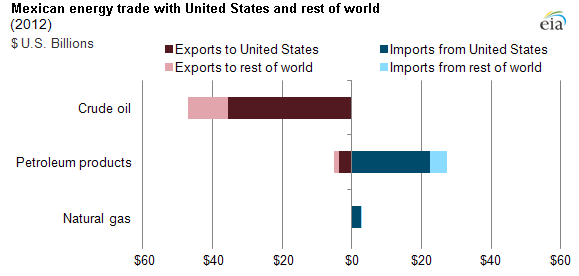
Mexico Week: U.S. is Mexico’s primary energy trade partner amid shifting trade dynamics

Note: : U.S.-Mexico coal and electricity trading is so small that it is not shown on this chart. The categories included in the chart are based on classification codes in the U.S. International Trade Commission's Harmonized Tariff Schedule. The natural gas category is based on Harmonized Tariff Schedule code 27.11, which includes natural gas liquids such as propane, butanes, ethylene and propylene.
This is the first in a series of five articles on U.S.-Mexico energy trade.
Energy trade between Mexico and the United States in 2012 topped $65 billion and accounted for 13% of the $494 billion in overall trade between the countries. Crude oil and petroleum products account for most of the energy trade; in 2012, Mexico was the third-largest crude oil exporter to the United States, behind only Canada and Saudi Arabia, accounting for 11.4% of all U.S. crude oil imports.
The United States is Mexico's primary trading partner, for energy as well as other products, a point made by President Barack Obama in a speech in Mexico City on May 3, 2013. The level of U.S. energy trade with Mexico is based on several key factors:
- Refineries in the United States process significant amounts of imported Mexican heavy crude oil, some of which is re-exported to Mexico as lighter grade products such as gasoline and diesel fuel.
- Institutional restrictions limit the roles that foreign companies can play in Mexico's energy sector, especially in the oil sector.
- An integrated and growing network of cross-border natural gas pipelines facilitates rising U.S. natural gas exports to Mexico.
- Increasing production of crude oil and natural gas in the United States is changing the energy relationship between Mexico and the United States.
- A combination of limited capacity and incompatibilities between electricity transmission systems—except for the Southern California and Baja California region—limits electricity trade between the countries.
- Common use of some trading-point benchmarks such as West Texas Intermediate for crude oil and Henry Hub and Houston Ship Channel for natural gas informs price discovery, commercial decision-making, and trading in both countries.
The trade value of various forms of energy exchanged between the United States and the rest of the world and Mexico varies greatly by product. Most of Mexico's energy trade relates to crude oil exports (see charts below).

Note: : U.S.-Mexico coal and electricity trading is so small that it is not shown on this chart. The categories included in the chart are based on classification codes in the U.S. International Trade Commission's Harmonized Tariff Schedule. The natural gas category is based on Harmonized Tariff Schedule code 27.11, which includes natural gas liquids such as propane, butanes, ethylene and propylene.
Crude oil: Mexico was the ninth largest supplier of oil in the world in 2012 and is the third-largest oil supplier in the Western Hemisphere. During the first six months of 2012, total crude oil exports accounted for 13% of the value of Mexico's overall exports for goods and services. However, the amount of oil that Mexico produces has steadily decreased because of production declines from Cantarell and other large offshore fields. As a result, Mexican crude oil export volumes to the United States have also been in decline, and fell below 1 million bbl/day last year for the first time since 1994. Although the volume of crude oil that Mexico has exported to the United States has been declining, generally rising crude oil prices meant that the dollar value of these exports rose from $13.1 billion to $35.7 billion between 2003 and 2012. Mexico's state oil company Petroleos Mexicanos (Pemex) effectively controls crude oil production in Mexico.
Petroleum products: Despite its status as one of the world's largest crude oil exporters, Mexico is a net importer of refined petroleum products. In 2012, Mexico remained the largest volumetric importer of U.S. petroleum products, importing nearly one-fifth of all U.S. petroleum product exports and almost two-thirds more than Canada, the next highest importer. Mexico was the top importer of finished motor gasoline from the United States in 2012, accounting for nearly half of all U.S. exports. It was also the second-highest importer of U.S. distillate fuel oil behind the Netherlands, as its demand for distillate fuels exceeded what local refineries could provide. From 2003 to 2012, the dollar value of Mexico's net petroleum product imports from the United States rose from $0.6 billion to $18.7 billion.
Natural gas and liquefied natural gas: Mexico's domestic natural gas consumption is rising faster than domestic production, leading to both record pipeline gas imports from the United States and growth in the country's imports of liquefied natural gas (LNG). Natural gas trade between Mexico and the United States has been growing; estimated average daily net exports from the United States to Mexico so far in 2013 (January 1-May 6) has been 1.6 Bcf/d, up almost 29% over the same period in 2012. Many potential new natural gas pipeline connections between the two countries are planned. Pemex subsidiary PGPB imports most of the natural gas that enters the country via pipeline. In addition, private entities and state electric commission CFE also import pipeline gas into Mexico. In 2006, Mexico began importing LNG shipments from the Gulf of Mexico at its Altamira regasification terminal, and in 2008 began receiving LNG on the Pacific coast at its Costa Azul regasification terminal. Mexico has considerable natural gas resources, but the development of its unconventional shale gas is proceeding slowly.
Electricity: Electricity trade between the United States and Mexico has existed since 1905, but it remains small; Mexico has generally been a small exporter of electricity to the United States.
On Tuesday, Today in Energy will address Mexican crude oil production and exports to the United States.
For more information, see EIA's Country Analysis Brief for Mexico.